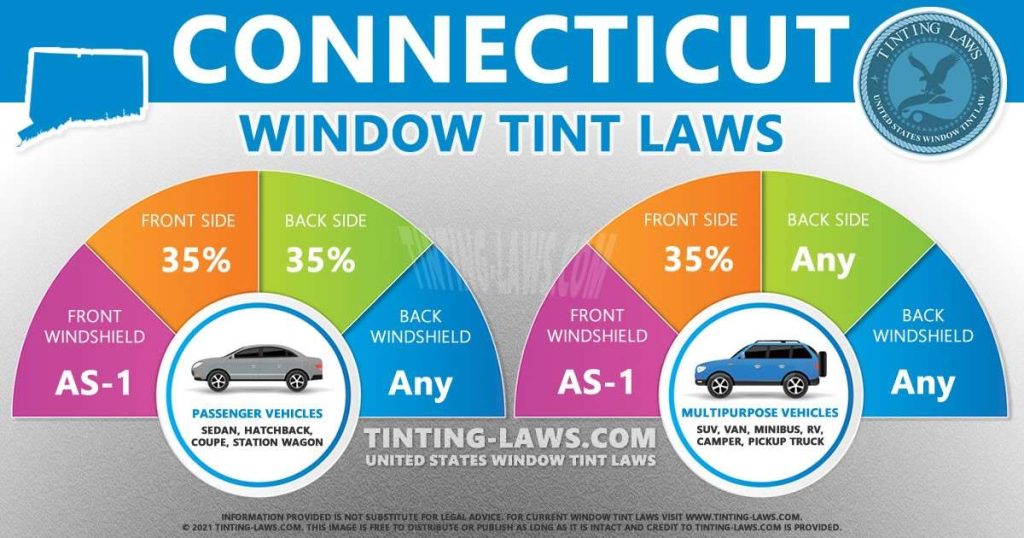Connecticut Window Tinting Laws
Car window tinting laws in Connecticut were enacted in 1994.
We have provided all the necessary information about your car’s window tint, including how dark or reflective the tint is allowed in your state.
There are also additional car window tinting rules and regulations in Connecticut so make sure you read all about it below.
Window tint darkness in Connecticut
The percent of visible light allowed through your car windows is called VLT: Visible Light Transmission.
The percentage of light allowed through your film and glass in Connecticut is very specific and different for sedan cars and SUV cars or vans.
Tint darkness for sedans:
- Windshield: Non-reflective tint is allowed above the manufacturer’s AS-1 line.
- Front Side windows: Must allow more than 35% of light in.
- Back Side windows: Must allow more than 35% of light in.
- Rear Window: Any darkness can be used.
Tint darkness for SUV and vans:
- Windshield: Non-reflective tint is allowed above the manufacturer’s AS-1 line.
- Front Side windows: Must allow more than 35% of light in.
- Back Side windows: Any darkness can be used.
- Rear Window: Any darkness can be used.
Window tint reflection in Connecticut
Window tint can reflect incoming light and reduce glare and heat.
Connecticut window tint law permits a certain window reflection when using a tint so make sure you pay attention to this as well.
Tint reflection for sedans:
- Front Side windows: Must not be more than 21% reflective.
- Back Side windows: Must not be more than 27% reflective.
Tint reflection for SUV and vans:
- Front Side windows: Must not be more than 21% reflective.
- Back Side windows: Must not be more than 27% reflective.
Other Connecticut window tint rules and regulations:
Connecticut does have several other important laws, rules and regulations pertaining to window tinting. They include the following:
- Side Mirrors: Dual side mirrors are required if the rear window is tinted.
- Restricted Colors: No window tint colors are explicitly prohibited.
- Tint Variance: State laws allow 3% light transmission tolerance.
- Certificates: Film manufacturers need to certify the film they sell in Connecticut. Check with your dealer to make sure they are using certified film.
- Stickers: The sticker to identify legal tinting is required between the film & glass on each tinted window.
- Medical Exceptions: Connecticut law allows medical exemptions for up to 20% VLT tint film.
Keep in mind that Connecticut tinting laws and regulations may be interpreted differently in your county or place of residence.
We always recommend double-checking our information with your local DMV or law enforcement authorities.

Our information about window tint laws in Connecticut was last updated in 2024.
Tinting laws in Connecticut were enacted in 1994.
In case any of our info provided is not up to date or correct be sure to contact us so we can fix it. Thanks!
Trusted industry leader in providing accurate window tint laws. Share with confidence:
State of Connecticut Info
Connecticut is the southernmost U.S. state in the New England region of the north-eastern United States.
It is bordered by Rhode Island to the east, Massachusetts to the north, and New York to the west and the south (with which it shares a water boundary in Long Island Sound).

Connecticut is named after the Connecticut River, a major U.S. river that approximately bisects the state.
It is the 3rd least extensive, the 29th most populous and 4th most densely populated of the 50 United States.
Capital: Hartford
Population: 3,605,597
Area: 5,543 sq mi (14,357 km2)
Cities in Connecticut: Hartford, New Haven, Stamford, Bridgeport, Norwalk, Greenwich, Waterbury, Danbury, West Hartford, Westport, Newtown, Meriden, Groton, New Britain, Hamden, Middletown, Fairfield, New Canaan, New London, Milford, Branford, Darien, Glastonbury, Wallingford, Ridgefield, Wethersfield, Bristol, Trumbull, Southington, Farmington, Torrington, East Hartford, Enfield, West Haven, Manchester, Simsbury, New Milford, Shelton, Storrs, Cheshire, Newington, Norwich, Old Saybrook, Naugatuck, Guilford, Southbury, North Haven, South Windsor, Lyme, Ansonia
Counties in Connecticut: Fairfield, Hartford, Litchfield, Middlesex, New Haven, New London, Tolland, Windham
Tint law references:
General Statutes of Connecticut, Title 13b, Chapter 246, Section 14-99g
Quick Reference on Tinted Windows (Connecticut DMV)
Medical exemption info:
Connecticut Application & Special Permit for Exemption from Tinted Window Requirements